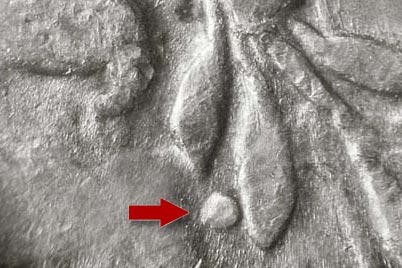-
- Coming Soon!
-
- Coming Soon!
-
- Coming Soon!
Research Reports
The 1926-S VAM 4 "Dot" variety

Some things just shouldn’t happen, like a Missouri plow-horse winning the Kentucky Derby, or you finding you can lose weight eating chocolate cake and milkshakes! But there it was—a large "extra berry" among the leaves on the lower reverse of this 1926-S Peace dollar and it looked like part of the design. Of course, it was not really an extra berry, as Leroy was quick to point out. Rather it was an unintended miscue on the part of some unknown mint engraver while he was preparing the die for use in the coin press. Specifically, what appears to be a raised "berry" is most likely the result of an engraver’s pointed tool inadvertently impacting the die. After all, who would notice? But the "extra berry" moniker has stuck, ever since this writer discovered the variety more than twenty years ago. Most would agree, the 1926-S "Dot on Reverse" VAM 4 is one of the more remarkable varieties in the Peace dollar Top 50, as there’s nothing quite like it anywhere else in the VAM universe.
| 1926-S VAM 4 PCGS Population April 2018 |
|||
|---|---|---|---|
| Grades of VAM 4 Slabbed Coins | Numbers of Coins In Particular Grades | ||
| VF to AU | 92 | ||
| MS60/61 | 5 | ||
| MS62 | 13 | ||
| MS63 | 8 | ||
| MS64 | 16 | ||
| MS65 | 5 | ||
| MS66 | 1 | ||
That said, the VAM 4 is not among of the rarest varieties in the Top 50 listings. Based on the PCGS Population numbers, this variety is readily obtainable in all grades up through AU. It then becomes more desirable in MS60 to MS64, and is truly rare only in MS65 or higher. Naturally, we’re only talking in terms of today’s marketplace, where the number of Peace dollar VAM collectors is limited. Looked at in a different light, PCGS has encountered a total of 143 VAM 4’s in all grades, and that means that if just 150 collectors wanted PCGS slabbed specimens in the next upturn, there just wouldn’t be enough to go around!
At this point we focus our attention on the actual die progression for this variety. The obverse, according to Dr. Close began with the VAM 6 die pair. The reverse was then replaced in the coin press with the "Dot on Reverse" die, and this new VAM 4 die pair then went through at least two clashing episodes, as seen in the accompanying research chart. Next, the obverse die was replaced with a new one, and the dies clashed again. Finally, die cracks and severe die polishing further damaged the die to the point that both dies were taken out of service. Even so, given that we’ve delineated twelve die stages for the VAM 4, this variety enjoyed quite an eventful lifetime.
1926-S VAM 4 "Dot Variety" Die Progression:
(Reconciling Oxman Die Stages and Dr. Close’s Die State Listings)

No part of this research or presentation may be reproduced by any means without the written consent of the author.
Editor’s Notes:
June 1, 2018 Dr. Close sent the following analysis of the current 1926-S Die Progression Chart:
Jeff, Nice work on the die progression of this variety! With coins in hand, here are my comments:
| Pre stage | My coin is uinclashed but has the die crack seen at 1 in date on obv. 1 of VAM 4 |
| Die Stage 1 | Looks good |
| Die Stage 2 | Looks good, may not exist |
| Die Stage 3 | Looks good |
| Die Stage 4 | Die Stage 2 has this same fork in die crack, although faintly. Appears to be the same as Die Stage 3 |
| Die Stage 5 | Looks good |
| Die Stage 6 | Looks good |
| Die Stage 7 | Has small die chip between curl & tail of 9 in date |
| Die Stage 8 | Would like to see one w/ unpolished clash mark on reverse. |
| Die Stage 9 | Clashing above hair on obv does not appear to have been polished, appears to be same as Die Stage 8. Has die crack on neck |
| Die Stage 10 | Evidence of die clashing above hair has been polished off. Die crack neck extends slightly into field above 9 |
| Die Stage 11 | Looks good, this was the original VAM 4A, the earlier die states were added later. |
| Die Stage 12 | Would be neat if someone found either of these possibilities! |

 1878-CC Varities
1878-CC Varities 1878-S VAM Listings - Part 1 (VAMs 1 to 25)
1878-S VAM Listings - Part 1 (VAMs 1 to 25) 1926-S VAM 4 "Dot Variety" Die Progression
1926-S VAM 4 "Dot Variety" Die Progression The 1880-O VAM 6 Die Progression Study
The 1880-O VAM 6 Die Progression Study